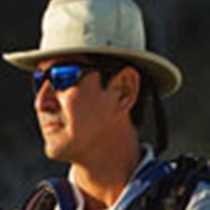Feranadina & Isabela Island
It is 5:15 AM and here we are, right in front of Fernandina Island, the western-most of all these wonderful islands. Far at the distance on a flank, white smoke indicating the remains of what used to be an eruption which started on April 11, today are effortless fumaroles shined by the rising morning sun; orange light, black lava and gray silvered curls like an elderly lady caressed by the warm equatorial breeze. From here you can see the vast ocean too; the closest landmass from here to the west is Marquesas Islands which could be reached after 30 days at 8 knots. We are isolated from time.
Our Expedition Leader Paula Tagle gave us an optional call and many of our guests started to come about. Silence, calm seas, tranquility, what a way to start our day.
We are headed to the northwestern side of Isabela Island; this site is called Punta Vicente Roca from our former Ecuadorian president. This is the home of the flightless cormorant and much more wildlife. These rocky shores call for an impressive panga ride. As soon as we get close, life revealed itself: crabs, iguanas, birds of different kinds and also our geology, tuff formations, lava dikes, many shapes and mineral compounds. This is a geologist’s paradise! Soon after, we headed back for snorkeling. Today’s features include green pacific turtles and many more fish; our underwater specialist Giancarlo Toti took a glimpse with our underwater camera. The condition at this site was outstanding; it was truly a wonderful experience.
All aboard and towards the equator, the line that separates both hemispheres on this planet. Today we had the visit of our kind Neptune Rex who was very upset because of the intruders (see photo below). Lucky for us, we had children onboard willing to walk the plank into our “shark infested pool.” We had a blast. Permit granted.
After a very interesting lecture from our colleague Paul Mc Farling we repositioned to Fernandina's only visitor site. This place is always very hard to describe. It is overwhelming. Marine iguanas by the hundreds, sea lions at their best, flightless cormorants, and crabs all over an array of solidified black lava flows and the white sandy beach for a dramatic contrast.
Back on board as the sun sets, we are ready to continue with our day. After a drink at the bar, we witnessed a moving recapitulation from our guests and naturalist Jean-Roch de Susanne.
This is the National Geographic Endeavour’s second week in the Galápagos Islands and it promises to be a prolonged fantastic relationship. She is a magnificent partner; I wish you could see her.
Greetings to you all, my dear readers, can’t wait to meet you.
From the distance,
It is 5:15 AM and here we are, right in front of Fernandina Island, the western-most of all these wonderful islands. Far at the distance on a flank, white smoke indicating the remains of what used to be an eruption which started on April 11, today are effortless fumaroles shined by the rising morning sun; orange light, black lava and gray silvered curls like an elderly lady caressed by the warm equatorial breeze. From here you can see the vast ocean too; the closest landmass from here to the west is Marquesas Islands which could be reached after 30 days at 8 knots. We are isolated from time.
Our Expedition Leader Paula Tagle gave us an optional call and many of our guests started to come about. Silence, calm seas, tranquility, what a way to start our day.
We are headed to the northwestern side of Isabela Island; this site is called Punta Vicente Roca from our former Ecuadorian president. This is the home of the flightless cormorant and much more wildlife. These rocky shores call for an impressive panga ride. As soon as we get close, life revealed itself: crabs, iguanas, birds of different kinds and also our geology, tuff formations, lava dikes, many shapes and mineral compounds. This is a geologist’s paradise! Soon after, we headed back for snorkeling. Today’s features include green pacific turtles and many more fish; our underwater specialist Giancarlo Toti took a glimpse with our underwater camera. The condition at this site was outstanding; it was truly a wonderful experience.
All aboard and towards the equator, the line that separates both hemispheres on this planet. Today we had the visit of our kind Neptune Rex who was very upset because of the intruders (see photo below). Lucky for us, we had children onboard willing to walk the plank into our “shark infested pool.” We had a blast. Permit granted.
After a very interesting lecture from our colleague Paul Mc Farling we repositioned to Fernandina's only visitor site. This place is always very hard to describe. It is overwhelming. Marine iguanas by the hundreds, sea lions at their best, flightless cormorants, and crabs all over an array of solidified black lava flows and the white sandy beach for a dramatic contrast.
Back on board as the sun sets, we are ready to continue with our day. After a drink at the bar, we witnessed a moving recapitulation from our guests and naturalist Jean-Roch de Susanne.
This is the National Geographic Endeavour’s second week in the Galápagos Islands and it promises to be a prolonged fantastic relationship. She is a magnificent partner; I wish you could see her.
Greetings to you all, my dear readers, can’t wait to meet you.
From the distance,




